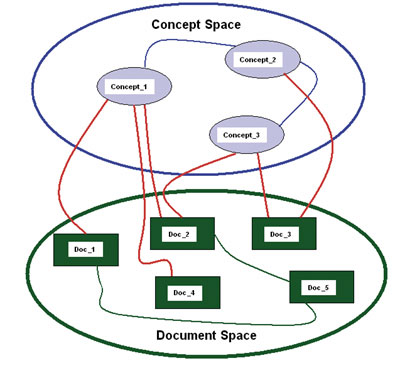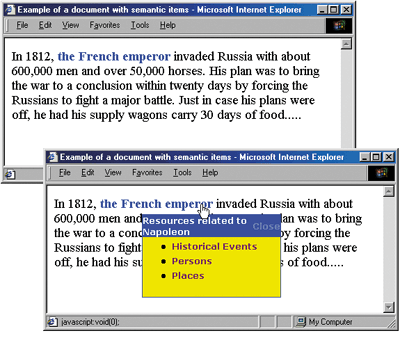 This issue in pdf Archive: |
|
|||||
Semantic Characterisation of Links and Documentsby Silvia Martelli and Oreste Signore Semantic characterisation can considerably enhance navigation possibilities and makes possible the presentation of documents for a real adaptive hypertext environment. Documents on the Web are often deeply structured, and this can be the origin of incompatibility between different views of the same object. Links are the essence of hypertext, but they are meaningful only if their semantics is clear, and perceivable by the user. As a consequence, it can be useful to have lightly structured documents, where some elements can be seen as 'semantic items' that identify concepts chracterising the specific parts of the document. Links can share basic semantic categories with these semantic items, and can be implemented in the XLink framework. This quite simple approach leads to a considerable enhancement of navigation possibilities, and makes it possible to present documents apropriately for a real adaptive hypertext environment. The Hyperlink Association Model
This basic association mechanism (see Figure 1) is totally independent of the document structuring. In the data space, documents are connected by extensional links. In the concept space - a simplified version of the Semantic Web architecture's ontology level - associations among concepts implement intensional links among documents. Two questions now arise:
A simple and effective way to implement intensional links is to identify the semantic items. This can help in several cases (for example, 'The French emperor' can be an implicit reference to 'Napoleon'). We can also characterise each semantic item with a specific semantic category (eg person, location, date, taxonomy) in order to tailor a document to specific user interests, eg a reader interested in space-time associations will get location and date items emphasised. The second question directly leads to the interaction metaphor issue. In addition to the case of taxonomic classifications, where we can make use of well-known thesaurus techniques, space and time can function as very powerful association mechanisms. A semantic item can point to a location, then, using an interaction metaphor based upon space, the user can either jump to other resources linked to the same location, or select a different location, and then find other resources related to this new location. This simple hyperlink association model can be implemented through a document, link and user model. Semantic Model of Documents Link Taxonomy and Model User Model Take the following fragment of an XML document, containing some semantic items:
A software agent can take this document as input, producing a richer XML document, where the expression "the French emperor" becomes the anchor of an extended link (using XLink terminology). When producing this document and also when displaying it, the software agent can examine the user profile, in order to produce a personalised document that will be displayed by the browser, as shown in Figure 2. Please contact: |
|||||



